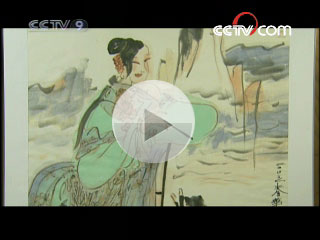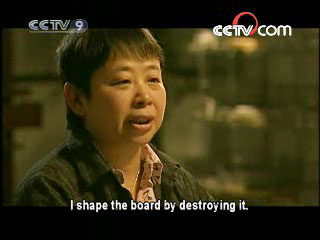------Program code: DO-080722-01039 (what's this?)
Source: CCTV.com
07-22-2008 08:43
 |
She is a female artist. Her painting style is fast and unconstrained. She studied printing, but was always fond of traditional Chinese painting.
Yang Chunhua believes that whether the style is printed or traditional Chinese, the charm is the same, in expressing an honest view of life.
 |
Yang Chunhua was born in Nanjing, Jiangsu Province in 1953. She is currently professor of printing art at Nanjing Arts Institute. As an artist, she is particularly noted for her traditional style works.
Yang Chunhua likes to listen to music while she paints. Her painting brush wafts over the paper like the wind; this is the essence of her unconstrained style. She paints naturally and freely; yet her work is harmonious and tranquil.
In Yang Chunhua’s paintings, the lines are elegant and strong. The influence of western colour-mixing also means the tones are rich and unique. Her style has developed throughout the decades she has spent printing.
Yang Chunhua was born in an artistic family. In the 1940s, her father Yang Han, began printing. Later he worked for the Shanghai People's Fine Arts Publishing House. Her mother was a graduate of the Central Academy of Fine Arts, and had been taught by such masters as Wu Zuoren. Because one of their ancestors had been a blacksmith, her father gave Chunhua the nickname “Tieying”, meaning iron hero. Yang Chunhua would later say that it was perhaps this nickname that gave rise to her interest in engraving. Tieying’s earliest memories are of the walls of her house covered with her father’s prints.
However, studying printing was not Yang Chunhua’s first choice. In 1973, Nanjing Arts Institute enrolled its first intake of worker, peasant and soldier students. Three students joined the Printing Department. Of them the only female was Yang Chunhua, who had just completed three years of rural labour.
So at the age of 20, Yang Chunhua started to learn printing. She developed a particular fondness for the watermark xylograph, since the charming images were similar to those of Chinese painting.
The process may be pleasurable, but the actual printing is hard work. If the watermark is to have beauty and charm, the paper must be kept wet. But the water sprayers available at the time were very simple.
Life at the Nanjing Arts Institute was hard, but at the same time happy and memorable. One of her classmates, Zhou Yiqing, would later become her husband.
On the workbench at her home, she keeps several special knives. She used them in creating several award-winning prints.
